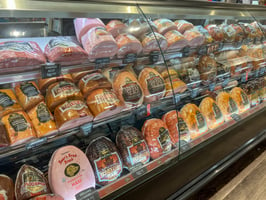A recent outbreak of Listeria monocytogenes has caused 43 illnesses and three deaths across...
Salmonella Outbreak Linked to Ready-to-Eat Charcuterie Meat Products
By Ryan Maus
CDC and USDA-FSIS have announced that sampler packages of ready
to-eat charcuterie meat products containing prosciutto, sweet soppressata, and dry coppa are implicated in an outbreak involving Salmonella serotype I 4:I:- that has caused 47 illnesses across 22 states. Nineteen of the patients interviewed reported eating a variety of ready-to-eat charcuterie meat products and shopper card records indicated ten had purchased the implicated product. The Minnesota Department of Agriculture collected and tested a sample of the unopened product from the home of an individual reporting illness and found it was positive for Salmonella I 4:I:-. Whole genome sequencing showed that the Salmonella in the product is closely related to the outbreak strain isolated from sick individuals. The manufacturer is recalling 11,097 pounds of product with a best by date of April 27, 2024.
Historically, low moisture ready-to-eat fermented/cured meat products have not been associated with foodborne pathogen outbreaks. However, three multistate outbreaks have now occurred since 2021.
Outbreaks Associated with Fermented/Cured Meat Products
| Year | Product | Pathogens | Illness |
| 2023 | Charcuterie Meats | Salmonella I 4:I:- | 47 |
| 2021 | Salami Sticks | Salmonella I 4,[5],12:i:- | 34 |
| 2021 | Italian-Style Meats | Salmonella Infantis and Salmonella Typhimurium |
40 |
In 2022, the USDA-FSIS released an “Outbreak Investigation After Action Review” discussing their findings from the 2021 outbreaks and what could be done to prevent future outbreaks. In both instances the products were produced using multiple interventions (e.g., fermentation and drying) to control Salmonella and other pathogens, and in both cases the process controls were inadequate. Concerning the salami sticks, FSIS determined that there was not sufficient evidence to support the fermentation and drying interventions to adequately control Salmonella. Concerning the Italian-style meats, FSIS determined that
the use of a reduced salt formulation and lack of validated scientific support to achieve a 5- log reduction
in Salmonella may have contributed to the outbreak. Commonly, a hurdle approach is used to control pathogen hazards in these types of products that include fermentation to a low pH, salt addition, and drying. Processing controls including meeting ‘degree hours’ parameters (for Staphylococcus aureus control), following a minimum number of drying days (for Trichinella elimination), and achieving a final water activity level (for shelf stability) were met by the outbreak establishments. However, neither establishment validated their process to achieve a 5-log reduction in Salmonella. In May 2023, FSIS released Notice 19-23 and “FSIS Ready-To-Eat Fermented, Salt-Cured, and Dried Products Guideline” to address the specific considerations related to supporting the lethality and shelf stability of these types of products. Likewise, FSIS indicated they will start verifying that establishments have adequate scientific support to produce these types of products safely.


.jpg?height=200&name=shutterstock_1196554828%20(1).jpg)